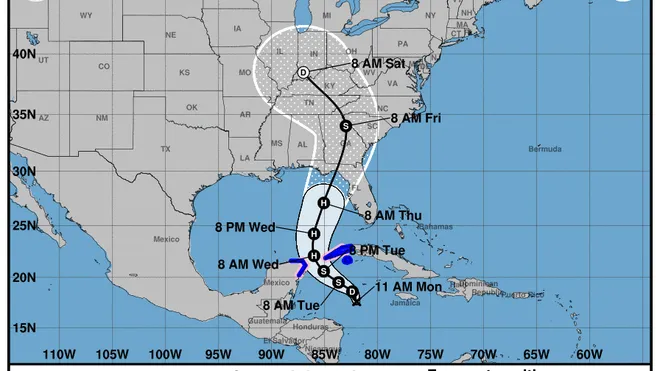Florida, known for its sunny beaches and vibrant cities, has a darker side that rears its head every hurricane season. Situated in the southeastern United States, Florida’s geographic location makes it highly susceptible to hurricanes, which can cause immense devastation to lives, property, and the environment.
Hurricanes are more than just extreme weather events; they shape the economic, social, and environmental fabric of the state. Understanding the long-term impact of hurricanes in Florida is crucial, as climate change and rapid population growth have made this an increasingly pressing issue.
The Anatomy of a Hurricane
Before delving into the specific impact of hurricanes on Florida, it is essential to understand what a hurricane is. Hurricanes are powerful tropical cyclones characterized by strong winds, heavy rainfall, and storm surges.
These storms are classified into five categories based on wind speed, with Category 5 being the most severe, exhibiting wind speeds exceeding 157 miles per hour.
The Atlantic hurricane season runs from June 1st to November 30th, with the peak usually occurring between mid-August and late October. Hurricanes form in the warm waters of the Atlantic Ocean, often moving towards the Gulf of Mexico, putting Florida in their direct path.
A Historical Perspective on Hurricanes in Florida
- The Labor Day Hurricane of 1935
One of the deadliest hurricanes in U.S. history, the Labor Day Hurricane of 1935, struck the Florida Keys with winds exceeding 185 miles per hour. This Category 5 hurricane left a trail of destruction, killing more than 400 people and reshaping how the U.S. handles disaster preparedness. - Hurricane Andrew (1992)
Hurricane Andrew remains one of the most destructive hurricanes ever to hit Florida. A Category 5 hurricane, Andrew devastated southern Florida, particularly in Miami-Dade County, causing over $27 billion in damage. The storm displaced thousands of people, destroyed over 63,000 homes, and significantly impacted Florida’s economy. Andrew also served as a wake-up call, leading to reforms in building codes and emergency management practices. - Hurricane Irma (2017)
In 2017, Hurricane Irma became one of the strongest Atlantic hurricanes on record. A massive storm with sustained winds of 185 miles per hour, Irma caused widespread damage across the Caribbean before making landfall in Florida. The storm left 6.7 million Florida residents without power, caused extensive flooding, and resulted in nearly $50 billion in damages. - Hurricane Ian (2022)
Hurricane Ian, which struck in September 2022, was another devastating Category 4 hurricane. Ian made landfall near Fort Myers, causing catastrophic flooding, extensive wind damage, and significant loss of life. The storm displaced tens of thousands of residents, caused over $112 billion in damages, and highlighted Florida’s ongoing vulnerability to climate-related disasters.
Economic and Environmental Impact
- Economic Toll
Hurricanes wreak havoc on Florida’s economy, particularly in sectors like tourism, agriculture, and real estate. The tourism industry, a primary revenue source for the state, suffers greatly as hurricanes disrupt travel, damage hotels, and force the closure of major attractions like Disney World. - The agricultural sector, especially citrus and sugarcane farming, also bears the brunt of the storms, with floods and strong winds destroying crops and infrastructure.
Hurricanes often result in billions of dollars in property damage. Rebuilding efforts are costly, and insurance companies face enormous payouts, leading to increased premiums for homeowners. As climate change exacerbates the intensity and frequency of storms, the economic toll is expected to rise.
- Environmental Consequences
Hurricanes dramatically affect Florida’s natural environment. Coastal ecosystems, including coral reefs, mangroves, and beaches, are particularly vulnerable. Storm surges erode beaches, while heavy rainfall causes runoff that can contaminate freshwater sources. Coral reefs, already threatened by warming waters, suffer further damage from the turbulent waves.
In addition, hurricanes can result in the loss of wildlife habitats, leading to a long-term reduction in biodiversity. Flooding from storm surges can also cause contamination of water sources with saltwater and pollutants, which has serious implications for both the environment and human health.
- Evacuation Plans
One of the most critical aspects of hurricane preparedness is evacuation planning. Local governments in Florida have worked tirelessly to develop comprehensive evacuation routes and plans for residents living in high-risk areas. The state uses a tiered evacuation system, categorizing zones by risk level and ordering evacuations accordingly when a hurricane is imminent. - Hurricane Shelters
In addition to evacuation routes, Florida has invested heavily in building and maintaining hurricane shelters. These shelters are designed to withstand high winds and offer a safe place for residents who cannot evacuate. - Public Awareness Campaigns
Florida’s government continuously works to raise public awareness about the risks of hurricanes. Educational campaigns inform residents on how to prepare emergency kits, secure their homes, and stay informed through weather alerts.
The Role of Climate Change
As global temperatures rise, so does the potential for more severe hurricanes. Warmer ocean waters fuel hurricanes, making them stronger and more destructive. In the future, Florida may see an increase in the frequency of Category 4 and 5 storms, which will compound the challenges the state already faces.
The Future of Florida in the Face of Hurricanes
Looking ahead, Florida must continue to innovate and adapt to the increasing threat of hurricanes. Urban planning will play a crucial role, with more cities considering long-term solutions like seawalls, flood barriers, and redesigned infrastructure to handle the impacts of stronger storms.
Conclusion
Hurricanes are an inevitable part of life in Florida, but they also present an opportunity for the state to build a more resilient and sustainable future. With climate change increasing the frequency and severity of these storms, Florida must remain proactive in its efforts to protect both its people and its economy.
The state’s history shows that it has the capacity to learn and adapt, but the future will require an even greater commitment to preparedness, innovation, and long-term planning.







